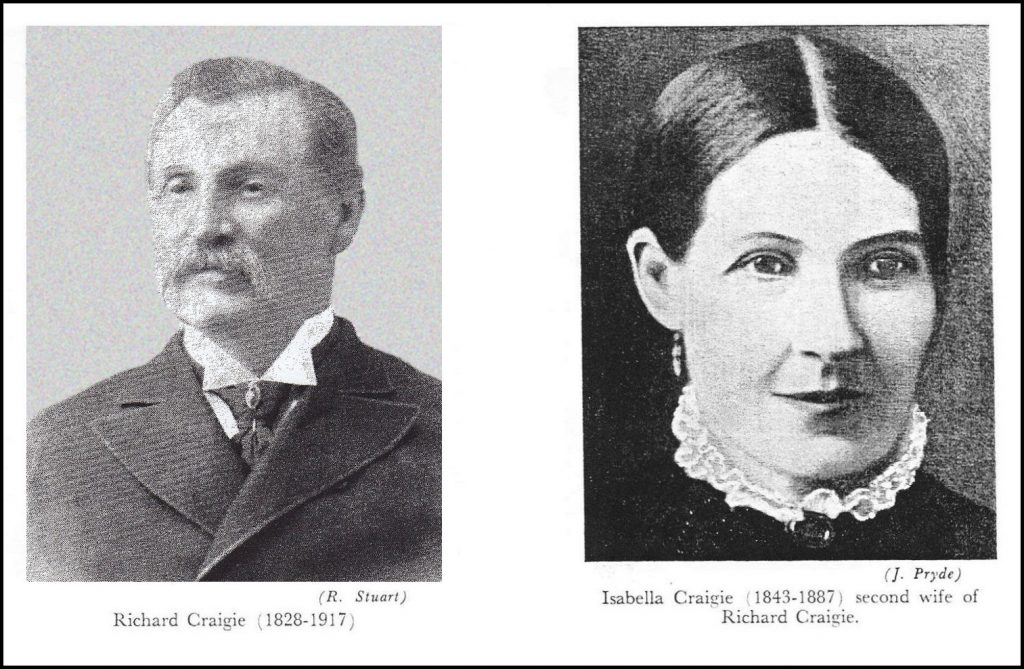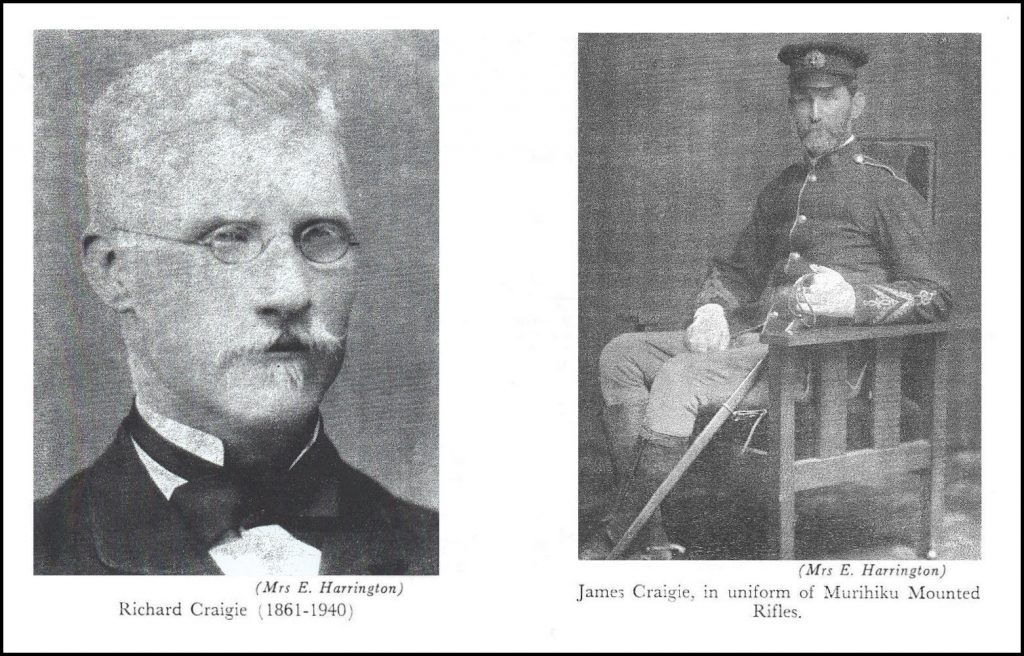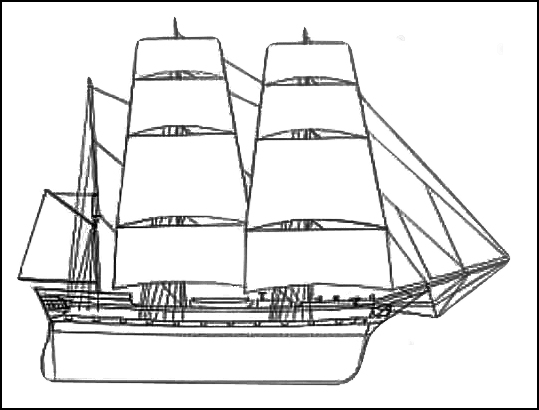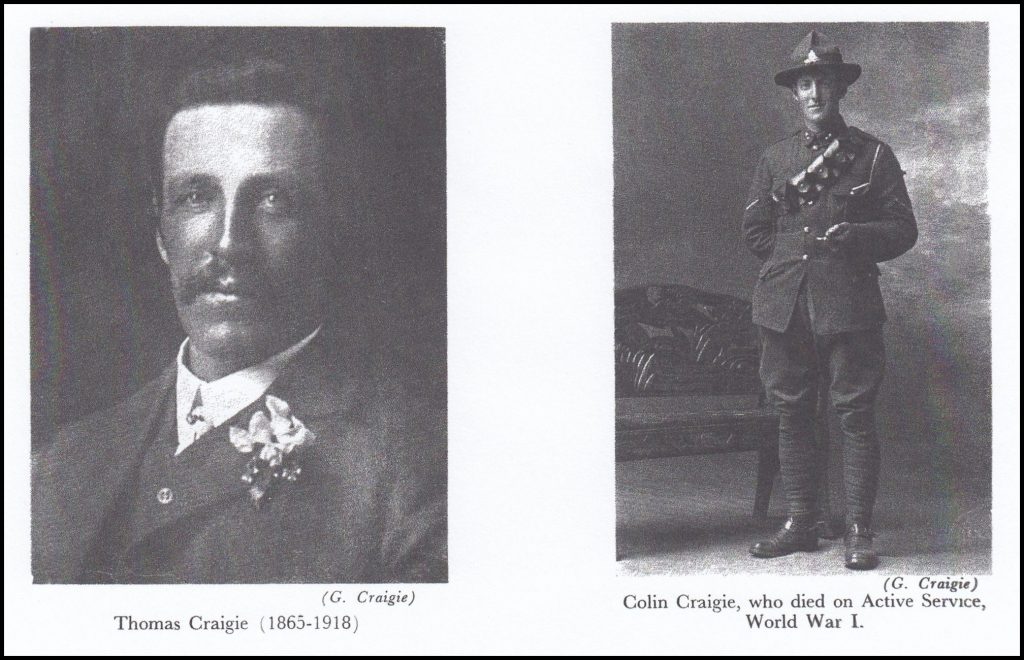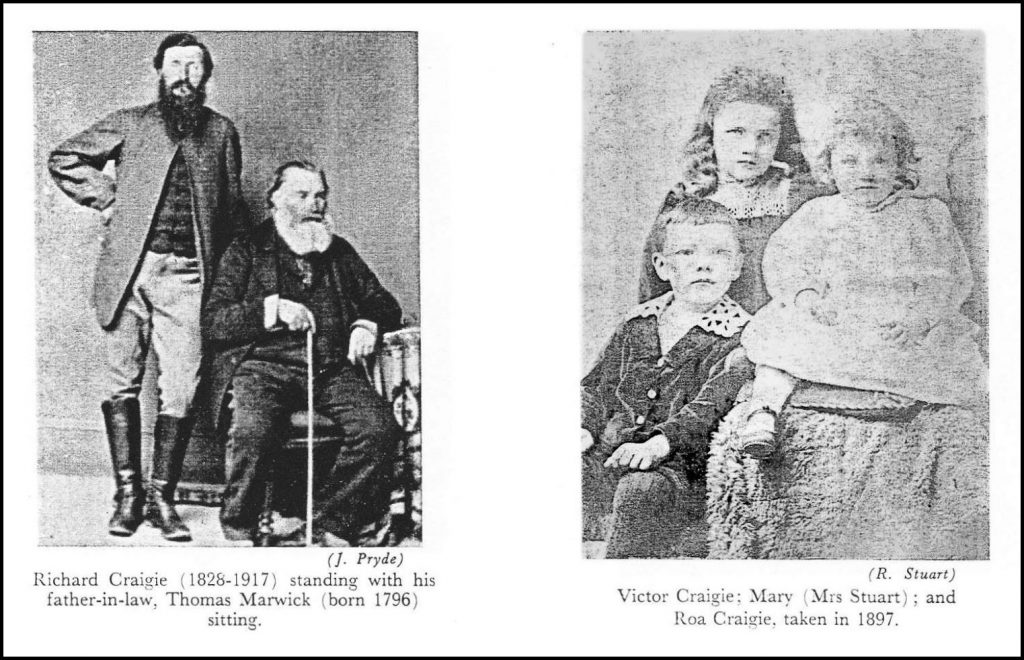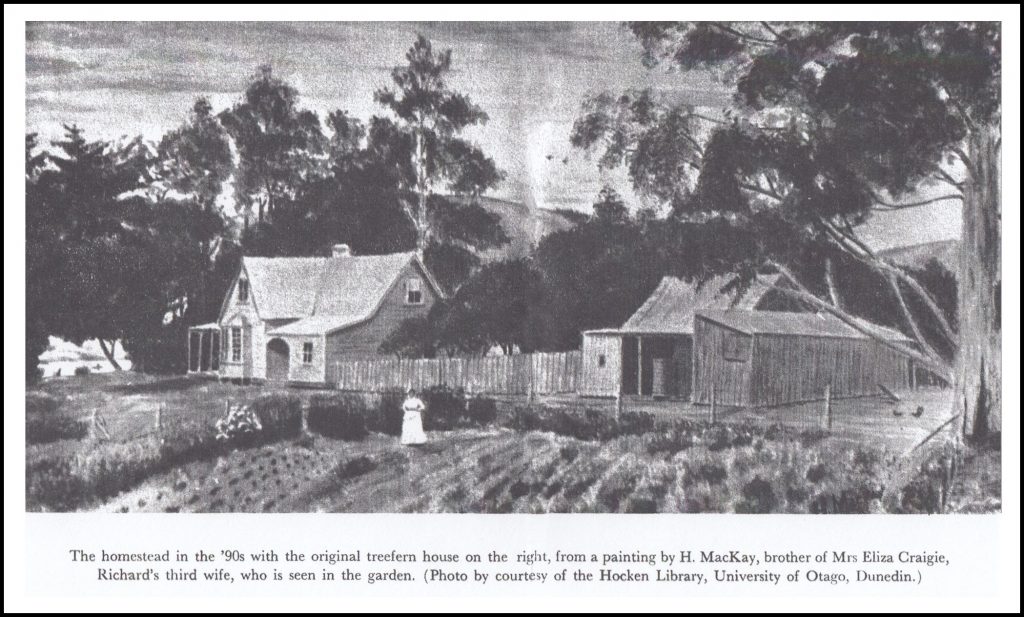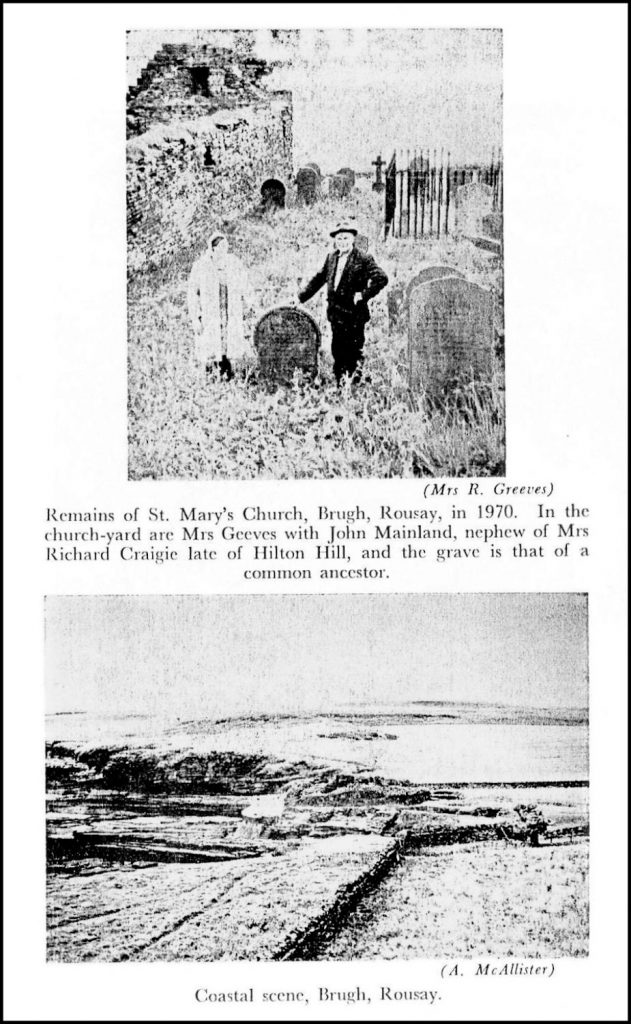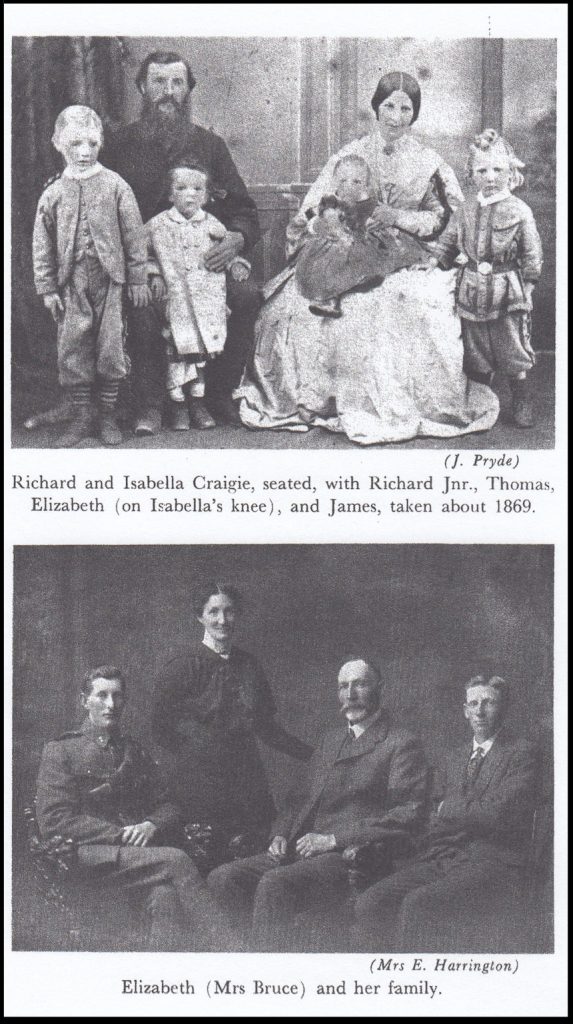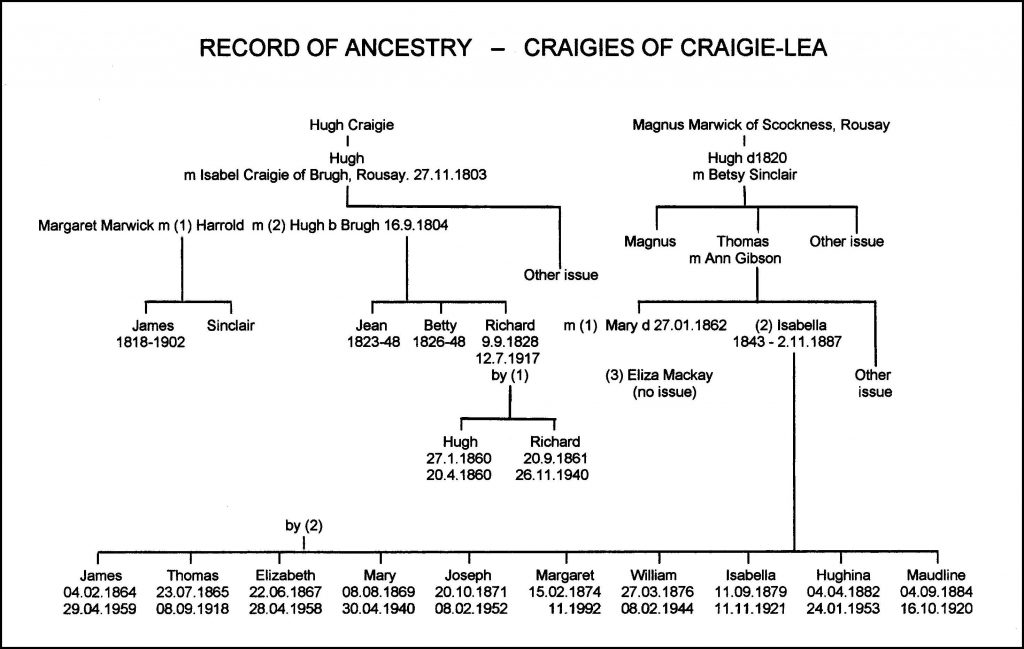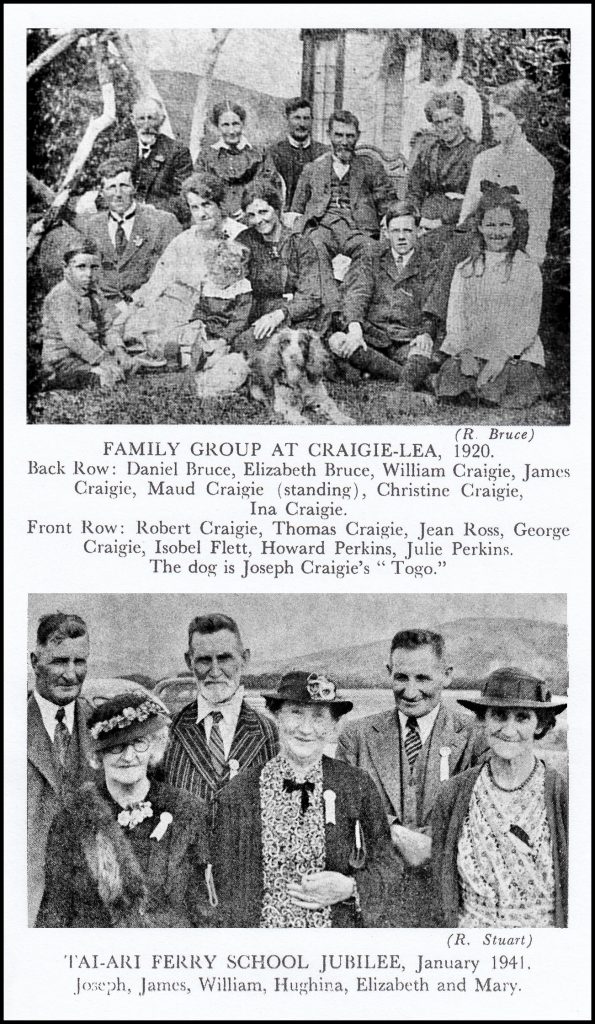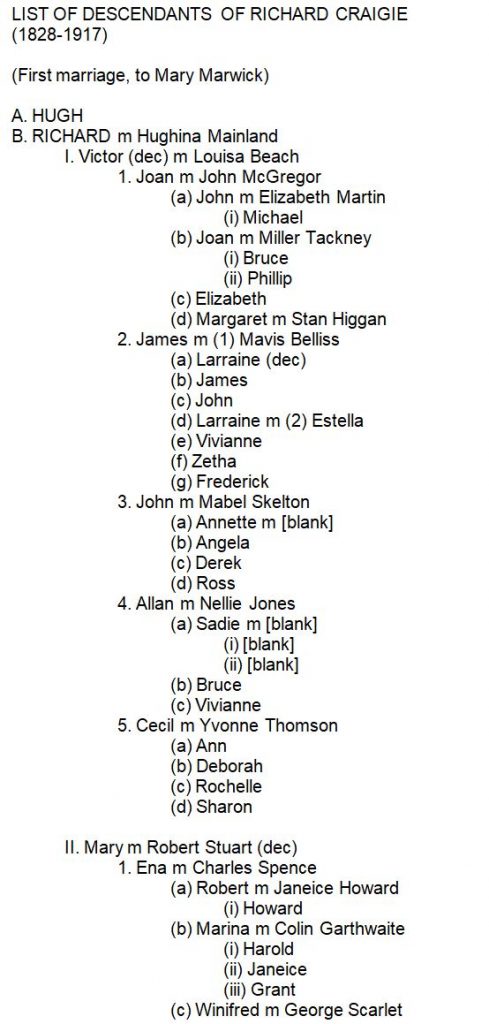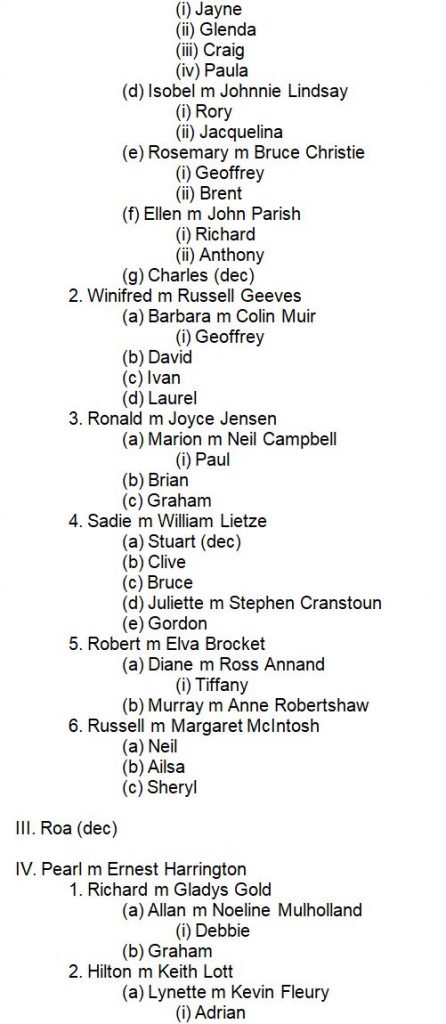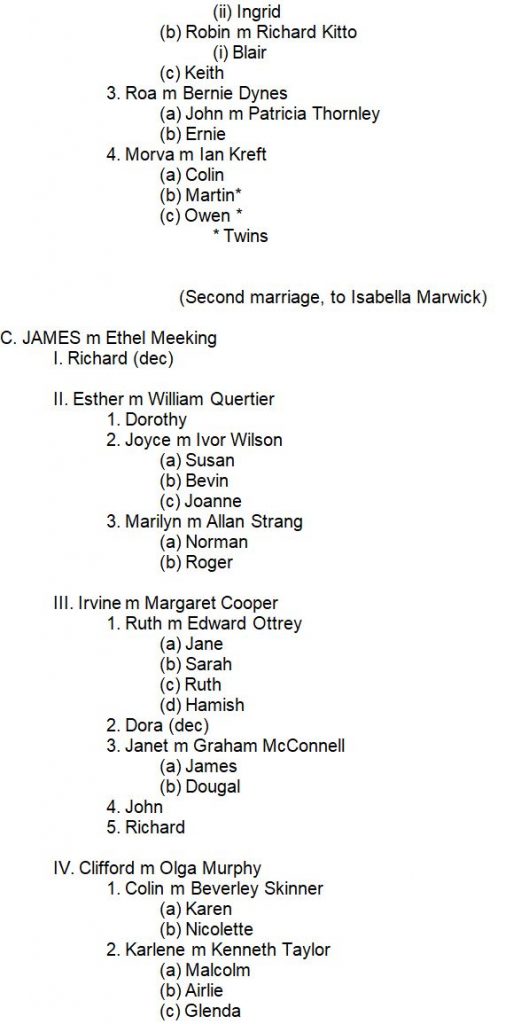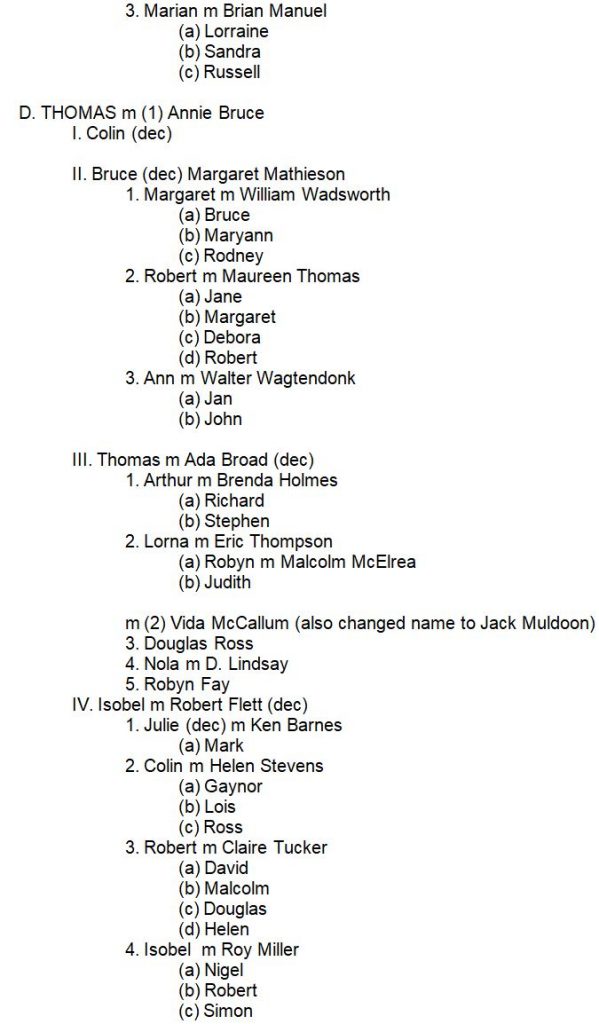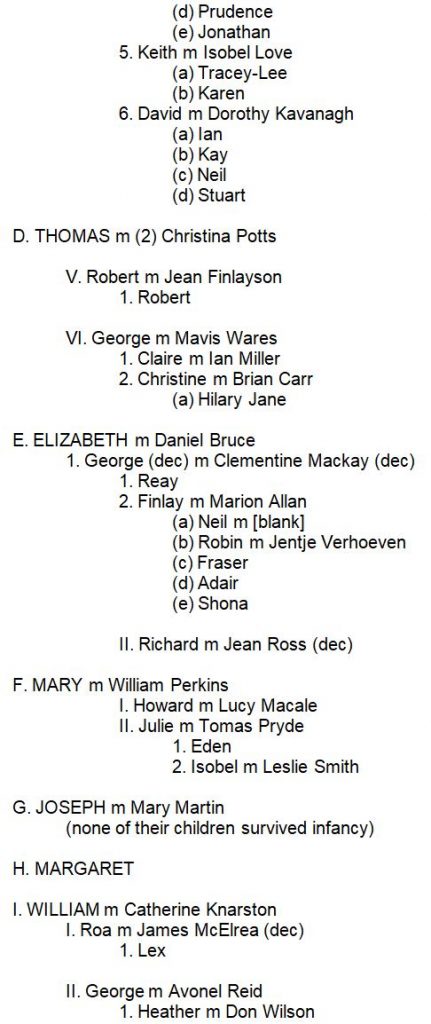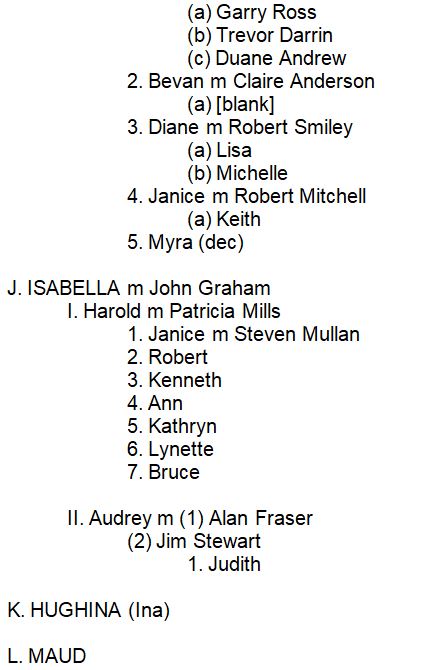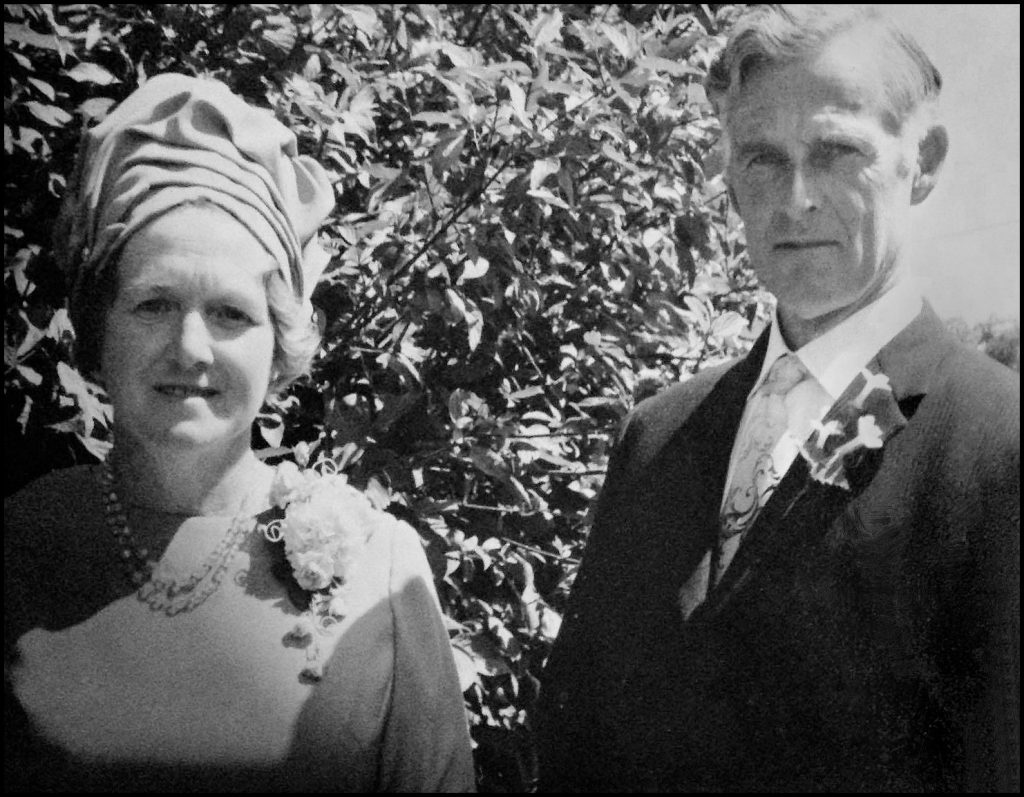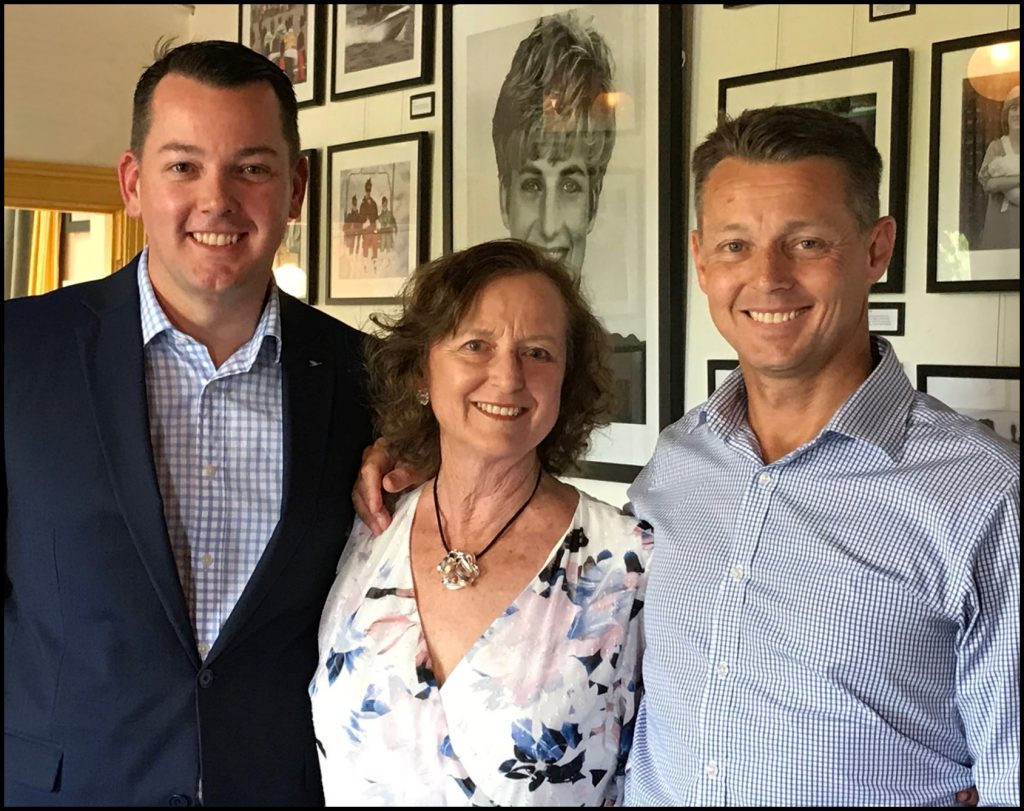
Written for the 125th Anniversary of the emigration of the
Craigies, of Brugh, Rousay, Orkney, to New Zealand
by
R. J. Stuart
DUNEDIN. N.Z.,
1973
FRONT COVER: The artist’s drawing shows, in light green, the
approximate shape of the 900-acre “Craigie-Lea” farm, with the
Taieri River (in light blue) forming the north-west boundary. The
darker green portion depicts the surrounding farm areas.
PREFACE
My grandmother, born Hughina Mainland, of Frotoft, Rousay, in 1860, came to New Zealand in 1878, meeting the people of Craigie-Lea soon afterwards. She later married Richard Craigie, junior, and my childhood memories of her are of tales by the fireside or bedside about life in Orkney but especially the exploits of members of the Craigie family.
In 1945, after war service in Italy, I was able to pay a brief visit to Orkney, where I stayed in Frotoft with Hughina’s sister, whose son took me about Rousay, indicating the sites of the homes of our ancestors, the Craigies of Brugh, Westside, as well as the Marwicks of Scockness and Trumland House, home of the later owners of Westside.
These experiences stimulated my interest in family history, and for its continuance I must record my appreciation of the assistance and encouragement given to me by my mother, named Mary Craigie Craigie, so that the name Craigie would remain alive for at least another generation; her sister, Pearl Craigie Harrington, Captain Clifford Craigie, as well as members of the booklet committee, Messrs George Craigie and Howard Perkins.
ORKNEY
Known as the Inse Ork to the ancient Celts and Orcades by the Romans, Orkney is an archipelago of about 70 islands containing 375 square miles of land spread over a space of 56 by 29 miles of the North Atlantic Ocean, within sight of the north of Scotland, from which it is separated by the stormy Pentland Filth. Ward Hill, in Hoy, at 1,564 feet, is the highest point in the group overlooking Scapa Flow, that famous natural anchorage surrounded by the southern isles and of considerable strategic importance in both world wars.
North of the principal island, Mainland, are the Inner North Isles which include Rousay, home of the Craigies as well as the Marwicks, who provided two wives for a Craigie, an island rounded in shape with central hills rising to 821 feet, giving views, including Fair Isle, far to the north and Foula, a mere speck on the northern horizon. Magnificent views are to be obtained from the road which encircles the island.
AVERAGE RAINFALL
The average rainfall in Orkney 125 years ago was 40.91 inches (1,035 mm.) on 105 days, ranging from 7.82 inches on 23 days in October to 0.94 inches on six days in April, while temperatures averaged 12.9 degrees celsius in July and 3.25 celsius in January. This mild weather at such a latitude (59 deg 10″ N) is understood when the effect of the warm North Atlantic Drift is considered. The sea is often so much warmer than the atmosphere that it is reputed that our ancestors, when out fishing during winter in their open boats, would jump into the sea to warm up their bodies.
Ample evidence is to be seen of the long occupation of Orkney by mankind, but nowhere more so than in a half-mile or so of the shoreline of the western side of Rousay, where the ancient monuments of the past include three broch-mounds, a huge stalled burial cairn, the ancient, long disused parish church of St. Mary, ruined buildings of the farm of Sigurd of Westness at Skaill, and the remains of the homestead of Brugh (or Brough) formerly the seat of the Craigies for over 400 years.
ORIGINS OF THE FAMILY
Researchers have traced a family tree from the 5th century, when King Erc ruled over the realm of Dal Riada, in present-day North Antrim, Ireland. His son, Loarn, was appanaged [a provision made for the maintenance of the younger children of kings and princes, consisting of a gift of land] in Lorn, Scotland, a dependency of Dal Riada. A later king of this line subdued the early residents of the Isle of Man. The family ranged across Scotland by the time of the death of Malcolm, King of Moray, who died in 1029 A.D. Malcolm’s daughter married Earl Sigurd the Stout, of Orkney, who was descended from the “Peace-Kings of Uppsala,” Sweden, whose great burial mounds, dating to the 7th century, are prominent features of the landscape.
They were the ancestors of a great family of Norsemen, one of whom, Whiteleg Halfdan, King of the Upplanders in Sweden, was the father of two kings whose descendants, Torf Einar and Grelod married. Einar was Earl of Orkney in 894 A.D. while his brother, Rolf, was the ancestor of the Dukes of Normandy and the English monarchs. Sigurd the Stout, killed in battle at Clontarf, Ireland, in 1014, was a great-grandson of Einar.
About 1162, there is a trace of a Henry de St. Clair, of Herdmanston. He was the descendant of a family which lived at Saint-Clair-sur-Ell, near St. Lo, in the Cotentin Peninsula, Normandy, whose great-grandson, Sir William Sinclair of Roslin, Scotland, married Isabella, a descendant of Sigurd the Stout. Their son, Earl Henry Sinclair I, of Orkney, a great figure in his day, having made many epic voyages including crossing the North Atlantic to Greenland, Markland, Helluland and even Vinland, had, as an aide, one James Craigie of Huip, who later married his masters daughter Margaret.
JAMES CRAIGIE
James Craigie was descended from a family resident in Linlithgowshire, Scotland, in the reign of David I (about 1120-1130), when Joannes de Craigie witnessed the signing of a charter. The name Craigie is derived from the Celtic word “creagach,” meaning a craggy ridge, and was applied to land in Linlithgowshire, later known as Craigiehall. The name of John de Craigy appears on the Ragman Roll of 1296. Another John de Craigy of that ilk was present at the coronation of King Robert II of the Scots, in 1371. In 1367, he had married Margaret, daughter of Sir John de Monfode. Their family included James Craigie of Huip, another son whose fate has not been discovered by the author, and Margaret, whose descendants maintained Craigiehall for many generations. James, well known to the Earl, Henry Sinclair I, of Orkney, acting as his aide when he went to meet the King of Denmark, acquired much property and influence in Orkney, owning land in Stronsay at the time of his marriage to Margaret Sinclair. By 1422, James had acquired sufficient estate and prestige to be admitted to the “hird,” of the King of Norway as a hirdman.
A “hird” is a bodyguard of hand-picked, well-born warriors through which ranks lay the road to high position in the State. In due course, he was recognised as being a “goodman ” or member of the “godings,” the aristocracy of Orkney. He was also described as “armiger,” that is, he was entitled to bear arms.
By 1443, the armiger entitlement was held by John Craigie, who was also a “lawman,” a paid Crown position which, in 1468, carried a salary of £12 per annum. John’s son, James Craigie, of Brugh, fought at the Battle of Summerdale in Orkney on June 7, 1529. Also included in the victorious Orcadian force were John Craigie, of Banks, Rousay, William Craigie, and Gilbert Craigie.
BRUGH
The farm of Brugh, sometimes written Brough, is named from the “broch” on the coast nearby. The name means a fortified place, and is derived from the same origin as the present-day words of borough and burgh. It occupied a sizeable part of the ancient estate of Westness, owned by Sigurd of Westness in 1126-1137, the remainder forming the farm which was called Skaill. This ancient Westness is further west than the present-day farm of Westness, and was later known as Westside.
Some of the Craigies left Brugh and became involved in commercial activities, but the fortunes of the family at Brugh seemed to have early waned so that in 1556 the farm was sold to Sir Magnus Halcro of South Ronaldsay, a controversial clergyman of the day, but the Craigie family remained in residence.
In 1584, however, the farm was taken from the Halcro heirs by means of a rather dubious process of law by Lord Robert Stewart, a close friend of Lord Darnley and illegitimate son of King James V of Scotland, our ancestors remaining as tenants.
FEMALE HEIRS
At the beginning of the 17th century, the tenancy was left in the hands of female heirs, so to ensure the continuance of the name, a marriage was arranged with a relative, a Craigie from Dumbarnie in Scotland. The official positions previously held by the Brugh family now devolved on the next males in line, the Craigies of Gairsay, one of whom, Sir William Craigie, in 1653 was one of the wealthiest men in Orkney, owner of the Skali, or mansion, of Sweyn Asliefson, the last of the Viking chiefs, killed in a raid on Dublin in 1171, which was then known as Langskaill. Sir William added to this building, including a two storeyed wing.
Returning to Brugh, we find that in 1803, Isabel Craigie, of Brugh, married Hugh Craigie, Jnr. We do not know which branch of the family he came from, but they later became tenants of the Brugh estate, now owned by the Traill family, where their son Hugh was born in 1804. Hugh grew up to be a typical young man of his day, kept occupied with woodworking, fishing and agricultural pursuits to occupy his time. When he was 18, he married a widow, Margaret Harrold, née Marwick, 25, who was mother of two sons, James (5) and Sinclair (3) of the earlier marriage.
HUGH AND MARGARET
Hugh and Margaret went to live in the village of Sourin at a house called Grindally, where their two daughters were born and later, on September 9, 1828, a son, Richard, arrived. Grindally would have been a typical house like the majority of those on Rousay at the time, with only two rooms called the but and the ben, both being used for all purposes, including accommodation for the household pets, which would include pigs, dogs and geese.
The walls of stone, three feet thick, would not have exceeded six feet in height. They would be unbroken, apart from the door-way. The low-pitched thatched roof would have an opening about two feet square, with an 18-inch high wooden “lum,” serving to provide light and ventilation near one gable end. Smoke from the smouldering peat on the hearth-stone, some distance away would eddy about the cottage (or cott), before making its way out through the lum. The doorway would open from a porch called the oot-by which also gave access to the back where the calves were reared and the fowls roosted.
The only sign of ornamentation would probably be the house door, made of deal boards, secured to the rails by square-headed wooden pins, set diamond-fashion on the outside.
IN THE KAIL-YARD
In the kail-yard, Hugh would grow his cabbages, as well as the “bere,” or barley, keeping a watch on the tide, so that he would be able to catch sufficient fish for the household as well as for bartering for other needs.
At certain seasons, large flocks of sea-birds would indicate the presence of shoals of small fish, known as sillocks, which, when fried whole and eaten with home-made bere bread, made a delicious meal, enjoyed by Orcadians to this day.
Often he would see sailing ships pass on the horizon, laden with deck cargoes of timber, which, if jettisoned because of bad weather, may wash ashore on the Orkney coasts. As duty had to be paid on the timber recovered, it often happened that soon after bad storms, the local residents would decide to do some ploughing, hiding the good planks from sight until the Customs men had returned to Kirkwall, when it would be salvaged for use in furniture-making or boat-building.
HALF-BROTHERS LEAVE
Richard grew up to see his half-brothers leave home to go to sea, James travelling to Rupert Land (now part of Canada) with the Hudson Bay Company as a seaman and trader, no doubt enlisting in the company’s service at Stromness. Sinclair, though also a seaman for a time, preferred to stay nearer to home. In due course, Hugh and Margaret returned to Brugh, where they were one of some 30 or 40 families spread over about 500 acres forming the district of Westside. All of those families were housed in thatched-roofed cottages, with windowless stone walls, though Brugh was larger than the rest, with three rooms.
OWNED BY ONE MAN
Most of Rousay, an exception being Frotoft, was owned by one man, who lived at Westness House, not far from Brugh. This extensive holding was inherited by Lieut-General Burroughs, who, after retirement from Army service, including a long period in India, decided to live at Rousay. As the old Traill homestead at Westness was too small for his needs, he erected a large and imposing mansion, Trumland House, about four miles east of Westness, where he established the first trees to grow on Rousay for more than 1,000 years.
Deciding to convert his holdings at Westside into a large sheep farm, he evicted all his tenants, providing them with passages to the colonies. Because he claimed the houses were insanitary, he set them all alight. The stone walls of most remain to this day.
Before Hugh and Margaret left Orkney, one of their daughters died of smallpox. After packing their effects, including the shawl Margaret wore on her wedding day, they sailed from Orkney for London. Before they could embark for the long voyage from London to New Zealand, their other daughter died of measles.
TO NEW ZEALAND
At London, Hugh and Margaret, saddened by the loss of their daughter, boarded the ship Bernicia. Their son Richard was among the 60 passengers. Also on board were Margaret’s two sons from her earlier marriage – James Harrold (31), with his wife Agnes (17), and Sinclair Harrold (29), whose wife Barbara was 34 at the time.
The ship also carried a cargo for the Infant settlement of Dunedin. It included “canvas, Europe rope, twilled blue shirts, bottled ale, porter, bottled wine, Martells brandy and prime Havana cigars.” Captain Arnold gave the orders to cast off on July 7, 1848, and soon the little ship was heading down the Thames toward the English Channel.
Little is known of the experiences of the company until the ship made its New Zealand landfall at New Plymouth, the first port of call here. From there, she visited Nelson and Wellington, before finally reaching Dunedin on December 12, 1848. The ship’s passengers would have experienced better weather, because of the season, than earlier immigrants on the run.
Our travellers would have been able to read, in the first issue of “Otago News,” published on the following day, the local headlines and also see the prices of food: Beef, 7d (6c) lb; bread, 10d (8c) a 4 lb loaf; butter, 1s 8d (17c) lb, fresh, or 1s (10c) lb, salt. Probably they all stayed on the ship for a few days, until they had unloaded their baggage and found suitable accommodation ashore.
EARLY DAYS IN NEW ZEALAND
Less than a month after the arrival of our family in Dunedin, on January 7, 1849, the ship Ajax arrived, bringing, among its passengers, one W. H. Valpy, a very wealthy man. He soon established a sawmill at Leith Valley, which was quite close to the section of land granted to our family at North-East Valley, finally sold by ‘Ina Craigie in 1921.
Soon, however, James Harrold set off for Scrogg’s Creek, site of the later Allanton railway station, from where he operated a punt service to the head of Lake Waihola, near Clarendon, leaving Agnes to live with the rest of the family. As the main south road was extended south, James saw the need for a ferry across the Taieri River. He soon established this amenity, using a 40ft by 10ft square-ended vessel, which was operated for him by Robert O’Neill, commonly known as “John Bull,” a former whaler from North America.
ACCOMMODATION HOUSE
By January 1851, James had established an accommodation house on the south bank of the river at Taieri Ferry and installed his young wife as manageress. The house was, years later, moved in two parts to form additions to other houses, one of which remains to this day. A return trip across the river by punt took about two hours. Motive power was provided by the action of the tide on the vessel’s rudders.
The Rev. T. Burns visited the site, as well as North-East Valley during his visitation.
About 10 years later, James and Agnes moved to Stewart Island, where they kept a boarding house for a number of years. Agnes acted as midwife for many years, while James engaged in boat-building activities, as well as owning a ship which ran between Bluff and Australia. In later years, he conducted a store, which was afterwards run by the only son Joseph, who was born on the island in 1868, but never married. Many relics of the HarroIds remain on the island, many of them in the Half Moon Bay Museum.
Besides owning a grant of farmland, later incorporated in Craigie-Lea, Sinclair Harrold and his wife Barbara owned a shop in Duddingstone, North-East Valley. They had no family so the Harrold property was taken over by Richard Craigie on Sinclair’s retirement, though he lived on in his old home on “Razor Back” until his death about 1890.
MOVE TO “CRAIGIE-LEA”
Meanwhile, Richard had started to build a house at Craigie-Lea but before he had advanced far (he was engaged in shipping activities) his parents persuaded him to build them a little house. This was done and the small “punga” or tree-fern house was built for them about 1851, on the south side of the Taieri River, about a mile or so down-stream from the Ferry. Richard had an interest in the small coastal trader Endeavour (16 tons), which made news in 1853, when, after a week-long voyage from Lyttleton, arrived in Dunedin on November 5 with news of the passing of the New Zealand Constitution Act. Captain Raki skippered this ship for a time.
Richard, in partnership with his half-brother, the Harrolds, and another man, Peter McGill, established a sawmill at Anderson’s Bay, near the site of what was later a petrol station. There, timber was prepared for building activities in Dunedin, as well as for building a schooner, the Brother, of 16 tons.
The native forest, which, at the time, was down to the water’s edge, provided the mill with adequate supplies. However, the partnership was soon dissolved, as the new ship was used to begin trading from Dunedin to Taieri Ferry, Balclutha, Bluff and even as far as Auckland.
TAIERI MOUTH SHIPWRECK
On a voyage from Dunedin to Waihola, with a cargo of wheat, potatoes and other produce, including perhaps, barley – ostensibly for poultry food, but possibly also for distilling “moonshine” whisky in some of the less accessible gullies in the locality – the little ship, in September 1855, grounded on the bar at Taieri Mouth. It became a total loss.
To replace her, the partners built another ship on Otago Harbour. It was called the Hope. A cutter of 21 tons, registered number 40,354, she was 45.5 feet long with a beam of 15.6 feet and a depth of 5 feet. The Hope, which resumed the trade in 1856, was later sold and was finally wrecked at Moeraki on July 26, 1876.
A wharf shed built by the brothers in those far-off days is still standing, now half a mile from the river at Port Molyneux, the river course having changed during the 1878 flood. At times, the trip from Dunedin to Balclutha by ship took from a week to 10 days. The journey can now be accomplished by a car in an hour. Richard is reputed to have been the first to have worked Port Molyneux, in the Endeavour.
Hugh Craigie lived in the fern-tree cottage until his death at the age of 66. That occurred in 1870. His wife Margaret lived to the age of 88.
In 1857, there arrived from Scockness, Orkney, in the ship Jura, Thomas Marwick, a widower, with his daughters Mary and Isabella. Both were to have Craigie family connections.
It was in 1858 that Richard Craigie, with assistance from local tradesmen, completed the first part of Craigie-Lea homestead, near the fern-tree cottage.
RICHARD MARRIES
On April 15, 1859, he married Mary Marwick, who lived in the new house until her death on February 27, 1862. Then on October 1, of the same year, Richard married Isabella Marwick (born 1843).
Elizabeth Marwick had married Hugh Yorston on March 28, 1842 in Orkney, coming to New Zealand in the ship Alpine in 1859. Her daughter Betsy married Edward Perkins, whose son William married Mary Ann Craigie, fourth child of Isabella.
The Marwicks of Scockness had earlier been associated with the Craigies. A boy born about 1814 was christened “Craigie” but I have not been able to trace any connection between Margaret who married Richard Craigie, and the Scockness family.
Richard’s first son, Hugh, lived for less than three months. In those days, before the institution of the Plunket Society, his mother’s inability to breast-feed the infant proved fatal.
The second son, Richard, was fed by another woman, but his birth proved too much for Mary, who wasted away and died on February 27, 1862, aged about 21.
Richard married again soon after – on October 1, 1862 – this time Isabella Marwick, aged 19, and their family consisted of James, Thomas, Elizabeth, Mary, Joseph, Margaret, William, Isabella, Hughina, and Maud.
On March 2, 1887, Isabella died and her eldest daughter, Elizabeth, 20 years old, took over as housekeeper until New Year’s Day, 1890, when Richard again married. This time, his wife was Eliza Mackay, a daughter of a local settler who had come from Caithness, Scotland. There were no children from the third marriage.
MAGNIFICENT VIEW
The house at Craigie-Lea commanded a magnificent view of the river and the surrounding country, made up of rich flats, hills and ridges, many of them steep and bushclad. In the river opposite the side of the old home is an island more commonly called “Craigie’s Island.” Although never actually part of Craigie-Lea, it was once used for keeping the household pigs.
On the farm itself, many kinds of poultry were run. A wide selection of tree-fruits – raspberries, strawberries, gooseberries, apples, pears and so on – were grown in addition to vegetables, thus ensuring the provision of a varied menu of good food, for which Craigie-Lea was renowned.
RICHARD’S CAREER
Richard Craigie was for many years active in local affairs. He was chairman of the Taieri Ferry School Committee and among many other offices he held was that of member of the Waihola Road Board.
He was also greatly respected by the Maori people in the district. One indication of that was the presentation to him by Chief Korako Matene of a treasured paddle when the chief was no longer able to use it. The relic is now in the Otago Early Settlers’ Museum, Dunedin.
CRAIGIE-LEA FARM
Craigie-Lea farm contained about 900 acres. At one time, Richard also owned two farms on the Taieri, managed by his sons. They carried both sheep and cattle. Ultimately, what became a partnership was broken up.
Most of Craigie-Lea was sold to members of the Sinclair family in 1913. The exception was a ten-acre block surrounding the homestead.
Eliza Craigie died in April 1915 and Richard’s death followed on July 12, 1917. Hughina (Ina) remained in the homestead until her death in 1953, which followed a long illness. In 1953, the property was sold to the neighbouring Bungard family. Since then, it has again changed hands. The cottage and Craigie-Lea homestead have been demolished and most of the old landmarks, including Richard’s smithy, have disappeared.
The widow of the last surviving member of the family, James, who died in 1959, at the age of 95, undertook much research into its history. This poem, which she composed, caught some of the nostalgia which had gathered around the homestead:-
“FAREWELL TO THE OLD HOME”
In Craigie-Lea a bellbird sings
(Dear Craigie-Lea, on Taieri stream),
Its melody sweet memory brings,
Of days departed, as a dream.
The lofty bluegums, straight and tall,
Old sentinels of long ago,
Their sickled leaves still softly fall
On scattered gumnuts far below.
O Craigie-Lea where bellbirds sing
In lofty tree and bushy glade,
To youthful days we fondly cling,
For never can their influence fade.
The stately river flows along,
‘tween bushclad hillsides standing high,
Murmuring still its ancient song,
Of dusky warriors long gone by.
0 Craigie-Lea – dear Craigie-Lea!
Such treasured thoughts our memories fill,
And sacred shall those memories be,
Of loving hearts forever still.
Some of the bluegums still stand; Craigie’s Island still bisects the river, but hollows have been filled with spoil from the rises and a new house commands the river vista, so long a part of our family’s life.
RICHARD CRAIGIE’S FAMILY
A. HUGH: Born January 27, 1860; died April 20, 1860.
B. RICHARD: Born September 20, 1861; mother died February 1862; Richard married Jane Hughina Mainland (born March 28, 1860) on June 2, 1891. She had come to New Zealand in 1878 from Frotoft, Rousay, with a letter of introduction to the Craigies.
Richard lived at Craigie-Lea till marriage; then moved into “Uncle Tom Marwick’s house” on the farm; in 1900, he went to Pukeran, where he became the storekeeper; moved to 128 Albany Street, Dunedin, after five years; then dairy farming at “Hilton Hill,” Anderson’s Bay; wife died October 10, 1937; Richard died July 26, 1940. Interests: Book-keeping, fishing net-making and draughts.
C. JAMES: Born February 4., 1864; married Ethel May Meeking on August 7, 1902; died April 29, 1959; learned trade of cabinetmaking; then, with his brother Joseph, farmed at Pukeran; partnership dissolved after some years; he then leased and afterwards bought from the estate of Edward Perkins “Eden Farm,” later called ” Wairere,” Waikaka Valley. Interests: Violin playing; former member of Gore Orchestral Society; used to accompany his sister Mary, who played the piano, at functions in Taieri Ferry school; Murihiku Mounted Rifles officer.
D. THOMAS: Born July 29, 1865; married (1) Annie Bruce, 1892; (2) Christina Potts, November 26, 1911; died September 8, 1918; farmed at Craigie-Lea and then Milburn. Interests: Violin player. (See ” Dickie Family History” and “Strong is the Lion.”)
E. ELIZABETH: Born June 22, 1867; married Daniel Bruce, brother of Annie, who married Thomas, February, 1893; died, April 28, 1958; housekeeper at Craigie-Lea; then, with husband, farmed at Momona (“The Firs”) until 1917; later, lived at Bruce Rocks, Brighton. Interests: Piano and Scottish soloist; often accompanied her husband, who was a champion bagpipe player. (See “Strong is the Lion.”)
F. MARY ANN: Born August 8, 1869; married William Perkins, whose grandmother, Elizabeth Marwick (wife of Hugh Yorston), was eldest sister of Mary and Isabella, who both married Richard Craigie; died April 30, 1940; lived at Craigie-Lea until marriage; then, with husband, farmed at Waikaka Valley until retirement to Gore. Interests: Piano, singing; was at one time member of East Gore Presbyterian Church choir; later, was president, for a term, of Baptist Women’s Missionary Union.
G. JOSEPH: Born October 20, 1871; married Mary Martin, 1901; died February 8, 1952; farmed at Pukerau in partnership with James; then storekeeper at Drummond, Southland; for a time was manager of Hukariri Sheep Station, Heriot; farmed Te Tipua, near Brydone, Southland; worked at Glencoe sawmill, near Mataura, and before retiring to Christchurch conducted, with his wife, a store in Invercargill.
H. MARGARET: Born February 15, 1874; never married; drowned in Taieri River; November 1893. She is believed to have walked in her sleep at Stewart Island during a visit there some months before her death. It is said that on the night of the tragedy, she left her bed and dressed.
Mary, her sister, is believed to have wakened just as Margaret went out and, in reply to a question, Margaret said she would be back soon. Later, footprints were found along the river-side where pedestrians normally walked, but, instead of turning left to cross a floodgate on a creek, they continued straight into the water at the mouth of the creek. Searchers found the body in the river a few days later.
I. WILLIAM: Born March 27, 1876; married Catherine Knarston, August 1908; died February 8, 1944; farmed at Craigie-Lea, Henley and Owaka; was fond of horses and dogs; indicative of his attachment for dogs was his success in inducing Lassie to jump up and sit in front of him while riding his horse. Like Joseph, he had a dry sense of humour and played many practical jokes at Craigie-Lea and later.
J. ISABELLA (Bell): Born September 11, 1879; married. John Graham, November 1914; died November 11,1921; nursed in Wellington Hospital before marriage to John, who was variously a dredgernaster, flaxmill manager and farmer, ultimately near Riverton.
K. HUGHINA (Ina) MAINLAND: Born April 4, 1882; never married; died January 24, 1953; named after the wife of her brother Richard; had sketching ability and played the piano; visited Orkney a few years before her death; lived all her life at Craigie-Lea; with her sister Maud, cared for her father until his death.
L. MAUD: Born September 4, 1884; never married; died October 16, 1920; also nursed in Wellington and privately; like her sister was good sketcher, Richard intended to call her Madeline, but mis-spelt the name when registering the birth.
SOME INTERESTING ENTRIES IN REGISTERS AND FAMILY BIBLES
” Novr. 27th, 1803: Craigie and Craigie – Hugh Craigie and Isabel Craigie, Brough, Westside, were married before witnesses.”
” Septr. 16th, 1804: Craigie, Hugh, son to Hugh Craigie, jun., and Isabel Craigie, Brugh, Westside, was born, 24th, baptised ye 16th Ser. before witnesses.”
Hugh Craigie was born 27th January, 1860.
Richard Craigie was born 20th September, 1861, 9 o’clock at night, Friday.
James Craigie was born 4th February, 1864, at 2 o’clock, Thursday morning.
Thomas Craigie was born 23rd July, 1865, 9 o’clock Sabbath morning.
Elizabeth Craigie was born 22nd June, 1867, 5 o’clock, Saturday, p.m.
Mary Ann Craigie was born 8th August, 1869, 5 o’clock, Sabbath, a.m.
Joseph Craigie was born 27th October, 1871, 11 o’clock, Friclay, a.m.
Margaret Craigie was born 15th February, 1874, 9 o’clock, Sunday, p.m.
William Harrison Craigie was born March 27th, 1876, at the houre of 2 o’clock in the morning, Tuesday.
Isabella Jane Craigie born 11th Sept., at the hour, ½ past 11 o’clock, a.m., 1879, Thursday.
Hughina Mainland Craigie born 4th April, 1882, at the hour ½ past 8 o’clock p.m., Tuesday.
Maudlin Craigie born 4th September, 1884, on Thursday, at 2 o’clock p.m. (14-day moon age).
Mary Craigie, wife of Richard Craigie, died on 27th February, 10 o’clock, 1862.
BURIAL PLACES OF EARLY MEMBERS OF FAMILY
Hugh Craigie (1804-1870), Clarendon.
Margaret Craigie (1797-1885), (formerly Harrold, nee Marwick), Clarendon.
James Harrold, Stewart Island.
Agnes Harold, Stewart Island.
Joseph Harrold, Stewart Island.
Sinclair Harrold, Clarendon.
Barbara Harrold, Clarendon.
Richard Craigie (1828-1917), Otokia.
Mary Craigie, nee Marwick (died 1862), Clarendon.
Isabella. Craigie, nee Marwick (1843-1887), Clarendon.
Hugh Craigie (1860-1860), Clarendon.
Richard Craigie (1861-1940), Andersons Bay.
James Craigie (1864-1959), Gore.
Thomas Craigie (1865-1918), Clarendon.
Elizabeth Bruce (1867-1958), Mosgiel.
Mary Perkins (1869-1940), Gore.
Joseph Craigie (1817-1952), Invercargill.
Margaret Craigie (1874-1893), Clarendon.
William Craigie (1876-1944), Owaka.
Isabella Graham (1879-1919), Otokia.
Hughina Craigie (1882-1953), Otokia.
Maud Craigie (1884-1920), Otokia.
DIRECTORY
125th Anniversary Celebration, Dunedin,
May 11-13, 1973.
President: Richard Harrington.
Secretary: Ronald J. Stuart, 17 Embo Street, Dunedin.
Treasurer: Robert Stuart.
Programme Convener: George Craigie.
Committee: Robert Flett, Winifred Geeves, Joan McGregor, Roa McElrea, Morva Kreft, Hilton Harrington and Howard Perkins.
Principal Speakers: Friday evening, May 11, Irvine Craigie. Saturday evening: Rev. F. R. Belmer, toastmaster. Messrs Roy Miller and Andrew Robert Craigie.
Church service, Sunday: Preacher, Rev. F. R. Belmer.
SELECT BIBLIOGRAPHY
Anderson, William – ” The Scottish Nation,” 1863.
Clouston, J. Storer – “A History of Orkney,” 1932.
“Cyclopedia of New Zealand,” (Otago and Southland), 1905.
Hocken, T. M. – “Contributions to the Early History of New Zealand (Otago),” 1898.
Ingram, C. W. N., and Wheatley, P. 0. – “New Zealand Shipwrecks,” (third ed.), 1961.
Lemon, D. – ” More “Taieri Buildings,” 1972.
Marwick, H. – “Orkney,” 1951.
Moncrief and Hicks. – “The Clans of Scotland,” 1966-67.
Shaw, Margaret S. and Farrant, Edgar D. – “The Taieri Plain,” 1949.
Shearer, John and Mackay. – “The New Orkney Book,” 1966.
Wainwright, F. T. – “The Northern Isles,” 1962.
“The Dickie Pioneers and Descendants,” 1964.
“Strong is the Lion” – The story of the Bruces, 1972.
Taieri Ferry and Henley – “Our Native Place,” 1941.
The author of ‘Craigie-Lea’ Ronald John Stuart was the son of Robert William Francis Ferguson Stuart [1884-1961] and Mary Lydia Isabella Elizabeth Craigie [1893-1987]. Mary’s parents were Richard Craigie [1861-1940] and Jane Hughina Mainland [1860-1937]. Richard Craigie’s parents were Richard Harold Craigie [1828-1917] and Mary Mainland Marwick [1834-1862]. Jane Hughina Mainland’s parents were John Mainland [1819-1907] and Lydia Mowat [1825-1903], Cruseday, Frotoft, Rousay.
Jane Hughina went to NZ to act as housekeeper to her two elder brothers who had emigrated some years earlier. She had a letter of introduction to the Craigies who also hailed from Rousay. Husband Richard was born in NZ but both his parents were born in Rousay.
Ronald John Stuart was married to Joyce Jensen, and they had three children: Marion, Brian, and Graham.
Ron served with the NZ Forces in Italy during WW2. At the end of hostilities in 1945 he visited Rousay to meet his Mainland relatives. He made a return visit in 1984.
Ron passed away in 1989.
I am indebted to Janet Craigie-McConnell of Victoria, Australia, for sending me ‘Craigie-Lea’ for inclusion on the Rousay Remembered website. Born and raised in Southland, New Zealand, Janet is the daughter of Irvine Craigie and Margaret Cooper, and is also related to the booklet’s author.
A deep interest in her Craigie family roots began when she started a ‘pen-pal’ friendship in 1963 with Mary Craigie [nee McDonald], of Warsett, Egilsay. Janet is also directly connected to the Marwicks of Scockness and has visited Orkney a number of times, visiting her relation Robert C. Marwick on the way, who she says has been an invaluable source of information regarding her Craigie forebears.
Janet is No 1 bass drummer with the City of Melbourne Pipe Band. She also plays pipes, though only socially nowadays. Work and the Band involvement takes up most of her time – as do her four grandsons. A short while ago she sent me a large package containing not only a photocopy of ‘Craigie-Lea’ but a number of other documents of great interest – which have since been reproduced within this website.
